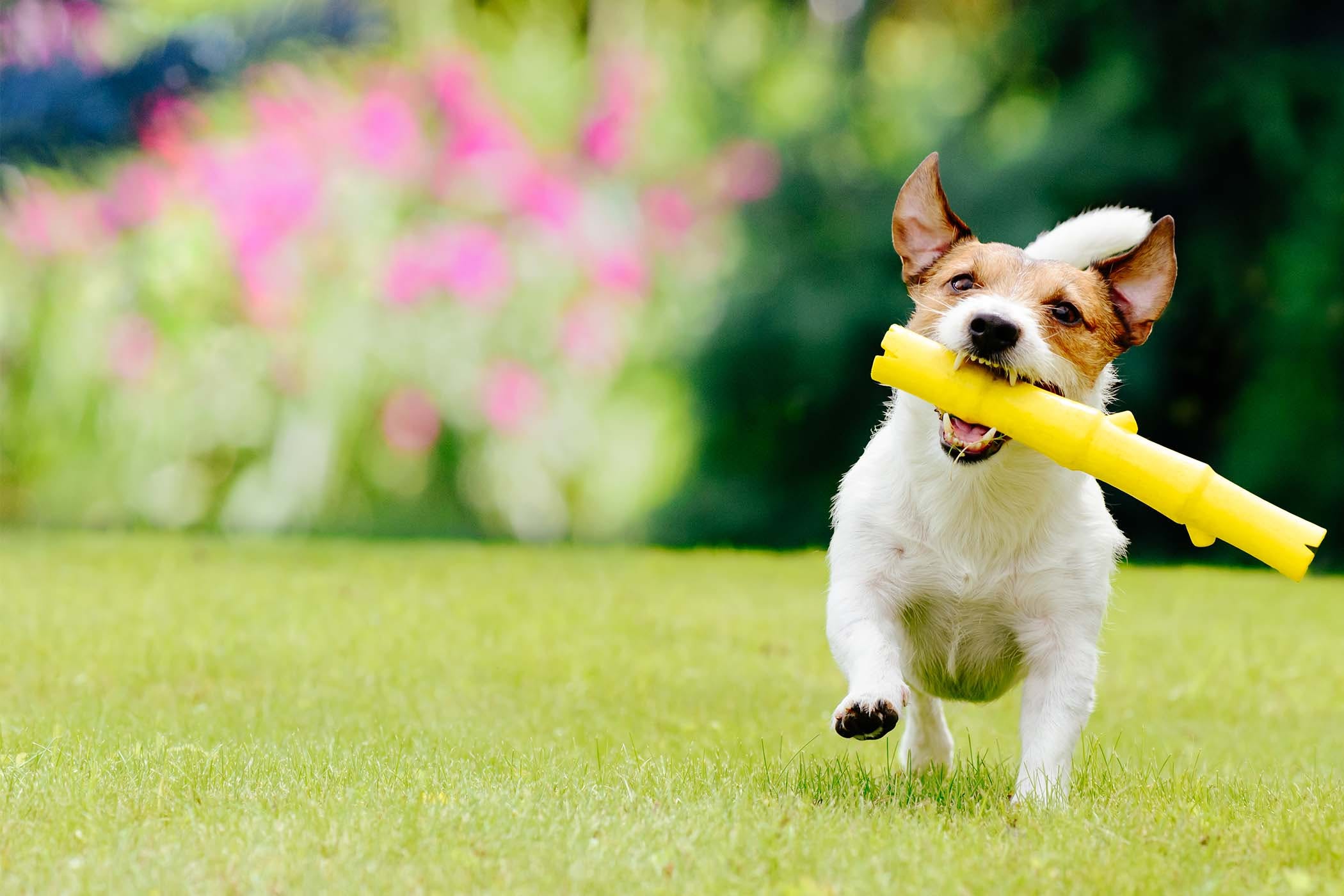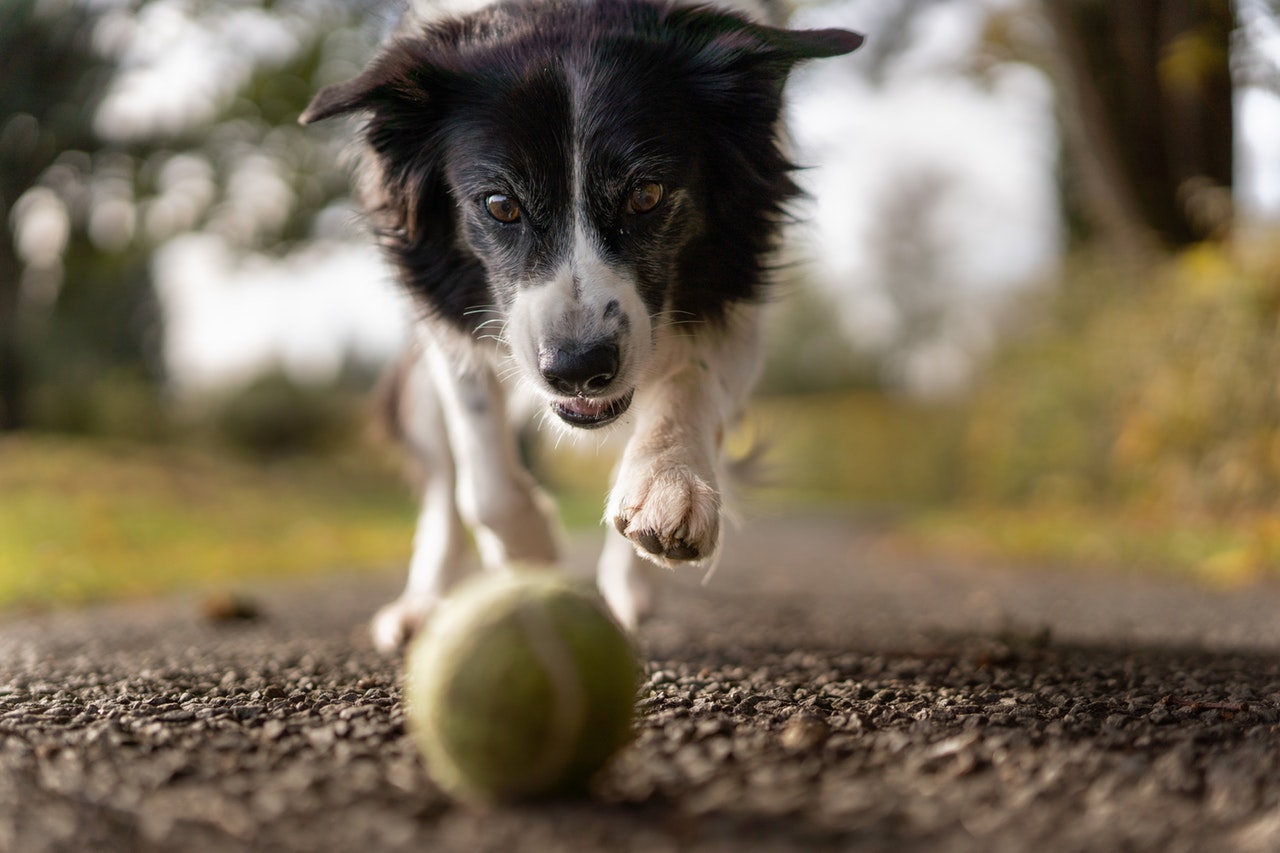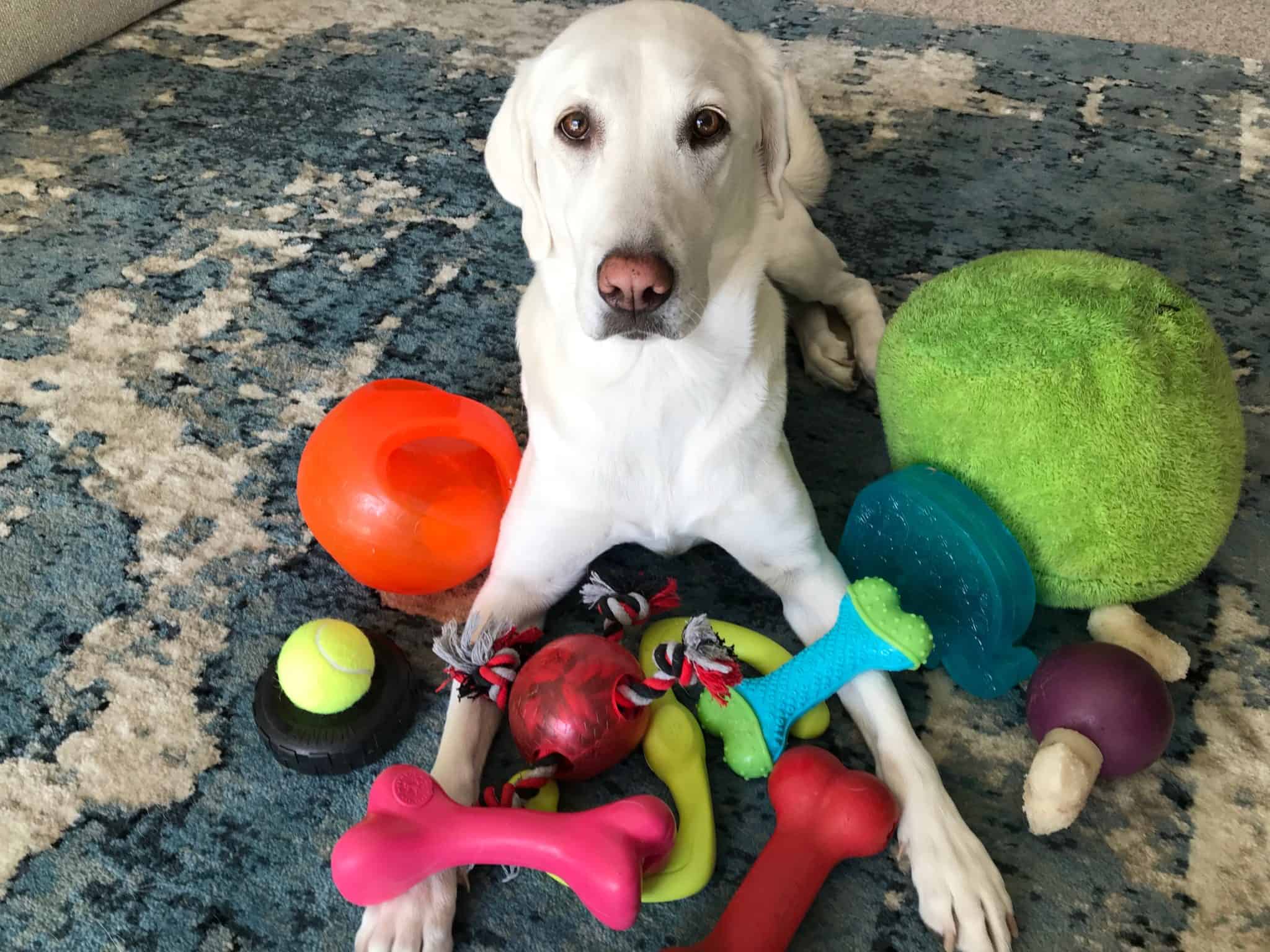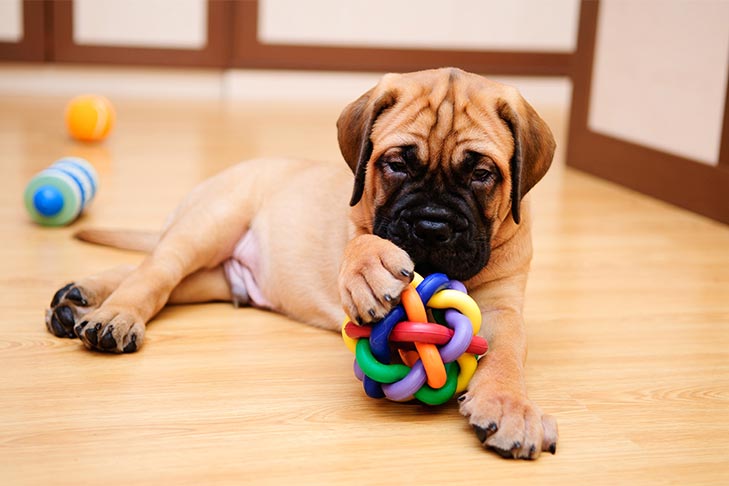How to teach dogs to pick up toys

Play Fetch is a great way to have fun with your dog and exercise at the same time. If you're lucky, your dog will naturally play fetch, but in essence, very few dogs understand the concept of finding and bringing home. Some dogs will chase the toy but then don't bring it back, while others just look at you with a confused expression, wondering why you keep throwing the toy away! Helping your dog learn to love picking up items can be as simple as finding a toy they really enjoy or as complex as training the entire sequence of chasing, picking, and bringing back the toy. Learn how to train a dog to pick up or teach a dog to pick up a toy through the article below.
Teach your dog to pick up toys – Choose the right toys
Dogs can be very concerned about the toys they will play with. Some like tennis balls, others like discs. And some simply prefer small sticks. Experiment with different toys and see which ones your dog enjoys the most. Avoid small or smooth balls that your dog can swallow, and don't choose something edible, such as raw hide. If the frisbee is your dog's favorite looking toy, buy a dog-specific toy. Throwing discs made for humans are hard enough to chip a dog's teeth. There is a wide range of good looking toys on the market. Here are some popular options to try:
If your dog doesn't like putting toys in his mouth, try soaking a plush toy or a tennis ball in chicken broth or stuffing a treat into an old sock. This will entice your dog to taste the toy and you can reward him with a treat. Your baby will soon realize that putting a toy in his mouth will keep you satisfied and you can then start teaching him how to pick up a toy.
Reluctantly taking prey
For dogs that really don't grasp the concept of chasing toys, you need to start with the basics. If your dog likes to play tug-of-war, teach him to fetch the toy so you can play tug-of-war with your dog. Start by playing a short game of tug of war with a soft toy that your dog loves to pull. Then, take the toy out of your dog's mouth, play around a bit by rocking the toy back and forth on the ground, and toss it away a little. If your dog runs to the toy, immediately grab it and start another fun game of tug of war. If your dog is just standing there looking at the toy you threw, reach out and shake the toy on the floor again until he finds the toy irresistible. As soon as your dog gets the toy, throw it away a little. Continue doing this until your dog chases the toy. When your dog does, you can reward your dog with another quick game of tug of war. Before long, your dog will confidently chase the toy and you can start to throw the toy at a longer distance. Encourage your dog to come back to you by grabbing the toy while he's sucking and playing tug-of-war with them. When your dog has the idea that bringing the toy back to you will lead to a play of tug of war, they will eagerly run and get the toy. When you start to throw the toy a few feet away, it helps to turn around and run away when your dog approaches you with the toy. This will encourage your dog to run faster and chase you. When your baby catches up with you, play tug of war with the toy. Finally, you won't have to play tug of war every time your dog picks up a toy,

On the other hand, if it's a treat your dog likes, you can teach them to take a toy with the promise of a tasty treat. Show your dog the toy and throw it a few feet away. Even if your dog just looks at the toy at first, praise and reward him. After three or four repetitions of this, encourage your dog to chase the toy. When the dog takes a step or two in that direction, praise and reward the dog with a treat. Repeat this three or four times. Next, toss the toy and see if your baby sniffs or puts his mouth in the toy. If your dog won't, touch the toy yourself — shake it a little. As soon as your dog moves his mouth towards the toy, praise him and reward him with a treat. Ask your baby for a little more each time until he actually picks up the toy. When your dog does that, Be full of praise and reward your baby with a treat! At this point, your baby will think the toy is pretty fun, so try tossing it further. Encourage your dog to come back to you once the toy is in its mouth. Some dogs have to learn that they can actually go and suck on something at the same time, so be patient. If your dog drops a toy, say “Uh-uh, get the toy” and point at it. Dogs will realize that the only way to earn a reward is to bring the toy to you, so they will either stop dropping it or will come back and pick up the toy when they drop it. After your dog learns the take-away game, they may enjoy it so much that you don't need to reward them every time you bring a toy home, but when it comes to getting started, remember to praise and reward them. Give your dog a treat every time they pick up a toy.
Another variation of this exercise is to use a toy that you can treat, such as a Genuine Dog Gear Toss 'N Treat or a treat ball. Let your dog know you're stuffing their favorite treats into the toy, then toss it a few feet away. When your dog sniffs or latches on the toy, quickly pick it up and give them some food inside. Then, stuff a few more things into the toy and repeat the sequence. Keep doing this until your dog learns that the fastest way to get the food is to bring the toy back to you.
The game "Hang a goat's head to sell dog meat"
If your dog loves to chase and pick up the toy he's looking for but doesn't want to bring it back to you, try a game of "hanging the dog's head" with two identical toys. Show your dog one of the toys. Get your dog excited, throw it away, and encourage the dog to pick up the toy. When your dog picks it up, call them home, then show the dog another toy and act as if you're going to throw it in the opposite direction. Your baby may drop the first toy and run to chase the second. While your dog chases the toy, pick up the first toy and repeat the sequence. This exercise will help your dog get used to picking up a toy and turning around to run towards you. Here's the next step: Call your dog's name when he picks up the first toy, but don't show him the second right away. Hopefully he'll turn around and run back to you while still holding the first toy in his mouth. When your dog approaches you, say "Put it down". Then show your dog the second toy. Baby will drop the first toy to chase the second toy. Now you won't have to walk far to pick up a toy your baby drops. This game will be easy for your dog to learn and can really tire him out. Eventually, your dog will probably realize that he should release the ball when you say “Drop it.” At that point, you can try picking up the ball the dog dropped and throwing it. This last step will eliminate the need for a second ball. Baby will drop the first toy to chase the second toy. Now you won't have to walk far to pick up a toy your baby drops. This game will be easy for your dog to learn and can really tire him out. Eventually, your dog will probably realize that he should release the ball when you say "Drop it." At that point, you can try picking up the ball the dog dropped and throwing it. This last step will eliminate the need for a second ball. Baby will drop the first toy to chase the second toy. Now you won't have to walk far to pick up a toy your baby drops. This game will be easy for your dog to learn and can really tire him out. Eventually, your dog will probably realize that he should release the ball when you say “Drop it.” At that point, you can try picking up the ball the dog dropped and throwing it. This last step will eliminate the need for a second ball.
More tips for picking up toys
- When your dog is happily trying to run after the toy, try to hold it back with a collar while you throw it. Say to the dog: “Oh, (dog's name)… do you want it? … are you going to get that ball?!”. When the dog seems really eager to pick up the toy, say excitedly, “Okay, get it!” and let go of the necklace. Your dog will feel a little more frustrated when you hold him, which will encourage him to be even more eager to find the toy when you let him go.
- If your dog chases the toy quickly but returns to you slowly, call them and run away from your dog at the exact moment he picks up the ball. Dogs love to chase and he probably won't be able to resist running after you. Praise your dog when he catches up with you. If you consistently do this for several weeks, your dog will come back faster, even when you're not running.
- .If your dog likes to play “catch-me-if-you-can” with a find toy, or if they just enjoy hanging out with him and playing by himself, attach a leash or light leash to the toy. play. Throw it away, and when your dog picks it up, shake the rope and run in the opposite direction, encouraging the dog to chase you. If your dog follows you with a toy, praise him and play a little game of tug of war or reward him with a treat. If your dog drops a toy, pull it behind you to let the dog chase. If the dog still tries to run away from the toy, pull the leash and roll it up. Praise and reward when your dog approaches you. Sometimes, throw the toy again quickly. Other times, let the dog hold the toy for a few minutes. This way, your dog won't learn that every time he runs to you, you take his toy away.
- If your dog brings home a toy but won't let you take it, say "Put it down," then place a delicious treat right in front of your dog's nose. Very few dogs can resist that, so he will probably let go of the toy. (If your dog doesn't, try a more interesting treat, such as a small piece of cheese or chicken.) When your dog releases the toy, praise them and reward them. After a few repetitions, your dog will learn to release the toy when you ask it to. Finally, you won't have to reward your dog every time he releases a toy. Throwing in a dog toy again can be rewarding. But remember to give your dog a treat from time to time so that they eagerly release the toy when you ask for it.
- If your dog returns to the toy but spits it out on the ground a few feet away, you can teach him to bring the toy closer to you. Watch the dog coming towards you. Just before your dog gets to the point where it's likely to release the toy, say "Bring the toy over here" and wave it with your arm while you walk a few feet in the opposite direction. When your dog sees you leaving, your dog will continue to follow you. When the dog comes to where you are standing, turn around and walk over to them. Tell them: “Put it down”. The dog will release the toy and come back. Praise your dog and throw toys. If you do this continuously for a few weeks, your dog will learn the meaning of the word “Bring the toy over” and you can remind him when he comes to bring you the toy.
- If you'd rather your dog put the toy in your hand than you would like him to drop the toy on the ground, you can teach him to "Put it here" into your hand. Before your dog has a chance to release the toy, place your hand underneath their jaw and say, “Put in here.” When your baby releases a toy, catch it. Praise your dog and throw the toy right away to reward them. Do this continuously for several days. Then, check on your dog by saying “Drop in here” and reach out your hand, facing up in front of their mouth. If your baby drops a toy in your hand, give him lots of praise and throw the toy back right away. If your dog drops the toy on the ground, say “Uh-uh, Drop it here” and keep your hand in the same position. Wiggle your fingers when you say “Release here” to show your dog that you want the toy in hand. If your dog picks up the toy and tries to put it in your hand, Praise them enthusiastically — even if the dog releases a toy that slips out of your hand! (Its purpose will improve with practice). If your dog continues to pick up the toy and drop it on the ground, or if they just stare at the toy on the ground, walk away. When your dog picks up the toy and follows you, try letting them drop the toy back into your hand. You may find that if you teach a small dog to drop a toy back into your hand, it will inevitably jump up to lick your hand. So, before teaching this skill, think about whether it's okay for your dog to jump on you, even if it's wet and muddy. Be careful what you wish for! or if they just stare at toys on the ground, walk away. When your dog picks up the toy and follows you, try letting them drop the toy back into your hand. You may find that if you teach a small dog to drop a toy back into your hand, it will inevitably jump up to lick your hand. So, before teaching this skill, think about whether it's okay for your dog to jump on you, even if it's wet and muddy. Be careful what you wish for! or if they just stare at toys on the ground, walk away. When your dog picks up the toy and follows you, try letting them drop the toy back into your hand. You may find that if you teach a small dog to drop a toy back into your hand, it will inevitably jump up to lick your hand. So, before teaching this skill, think about whether it's okay for your dog to jump on you, even if it's wet and muddy. Be careful what you wish for! Think about whether you're okay with your dog jumping on you, even if it's wet and muddy. Be careful what you wish for! Think about whether you're okay with your dog jumping on you, even if it's wet and muddy. Be careful what you wish for!
- If your dog releases a toy for you but then tries to snatch it up when you bend over to get it, teach your dog to sit and stay still while you pick up the toy:

– When your dog comes to you with the toy and releases the toy, ask him to sit and stay where he is. Praise your baby and bend over to pick up the toy. Your dog will most likely try to latch on to the toy.
If your dog doesn't, remind him to sit down and calmly pick up the toy. Once you have the toy and are upright again, say "Okay" to signal the dog no longer needs to sit still. Then reward your dog by throwing the toy away again.
If your baby tries to pick up a toy when you bend over to pick it up, say “Uh uh” and quickly get up. (If you have picked up the toy, drop it on the ground in front of you before standing up. If you haven't picked it up, simply stand up and leave the toy on the ground. If your dog has snatched the toy and is struggling keep it in your mouth, wait patiently until the dog drops to the ground again). Then ask your dog to sit and stay still. When your dog does, praise them. Bend down to pick up toys. If the dog does not sit still the second time, quickly straighten up again. Keep repeating this sequence until your dog realizes that if he wants you to throw the toy at him, he must sit and stay still while you pick up the toy. Finally, when your dog holds the position while you pick up the toy, say "Okay!" to signal the dog not to sit still.
Follow these rules every time you play fetch with your dog. Finally, you should be able to politely pick up the toy while your dog waits:
- If your dog has become interested in picking up toys, you can make the game more difficult for them with a few simple tricks. Try tossing toys uphill to make it harder for your baby to follow. If playing indoors, you can throw toys up the stairs. If your dog chases tennis balls, use a tennis racket or Chuckit! Ball Launcher to send the ball further.

- If your dog likes to chase discs, be careful not to throw them so that he doesn't jump in the air to catch them. Dogs can easily get injured jumping like this. While you may have seen dogs jump into the air to catch discs like in the movies, realize that dog handlers know how to throw discs to minimize the risk of injury. Throw the dish low to the ground so your dog can still catch it in the air but won't have to jump up and down on its hind legs.
- Keep your play sessions short and end the game while your dog still wants to play. If your dog gives up first, he may have grown bored of the game. Instead, let your dog want to play more. If your dog is still a puppy (under 6 to 12 months of age, depending on breed), be especially careful not to overexert them as that can permanently damage the dog's joints. .